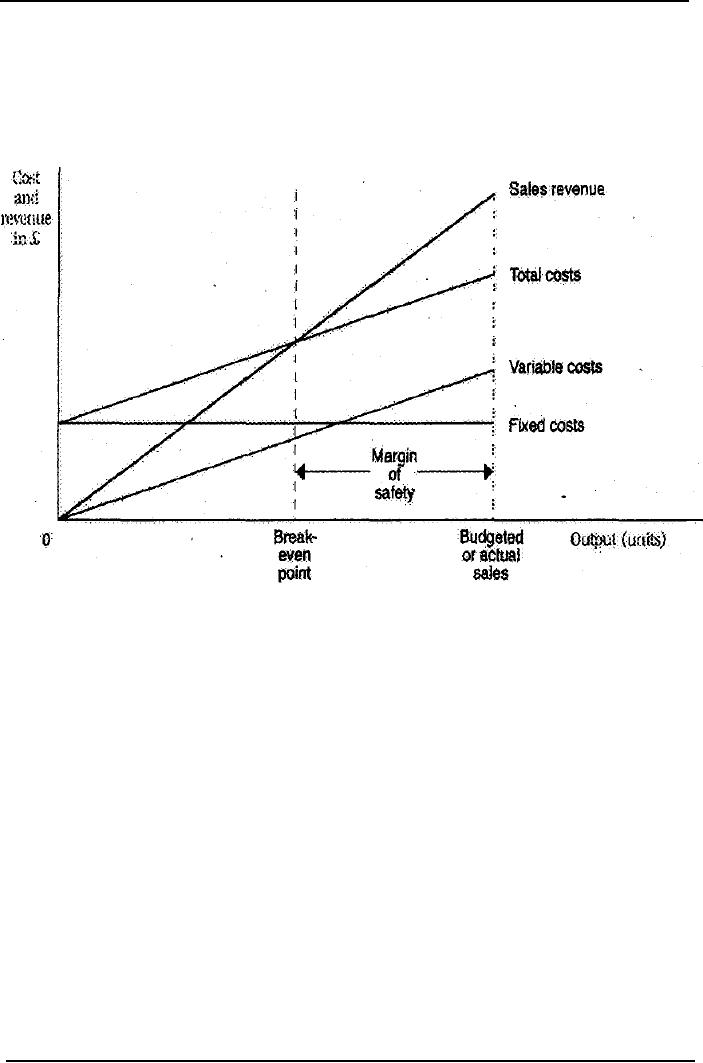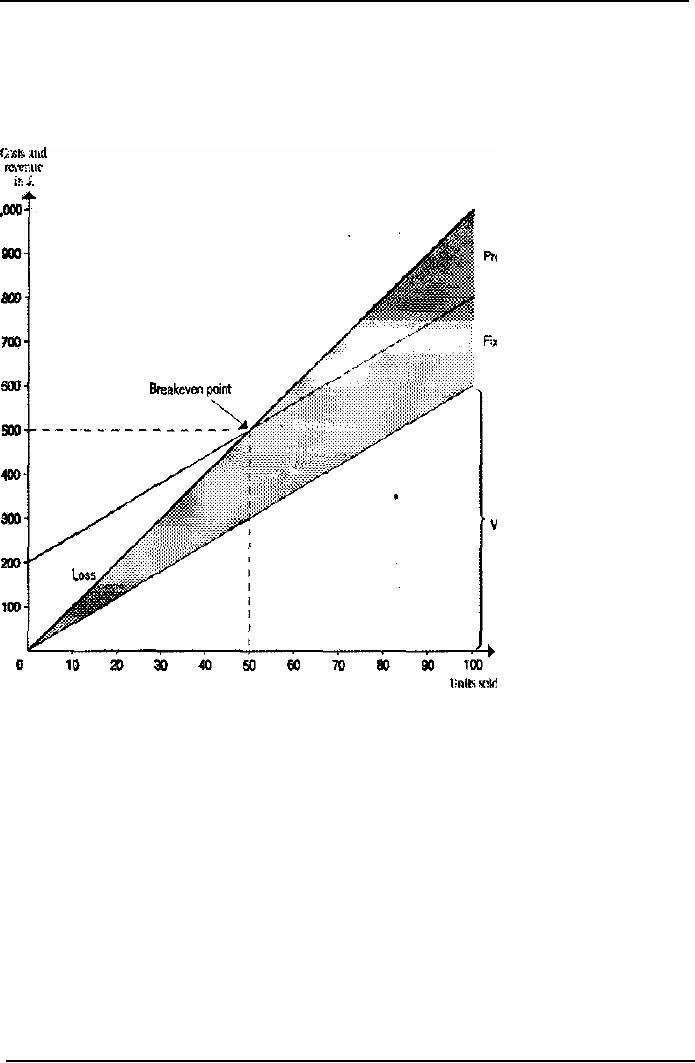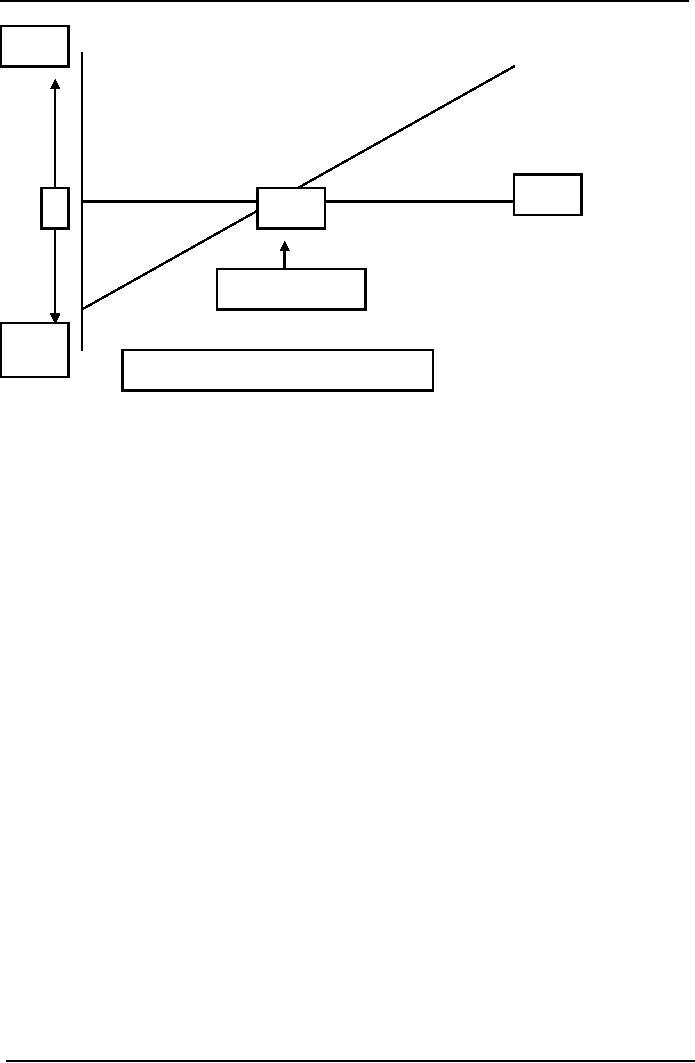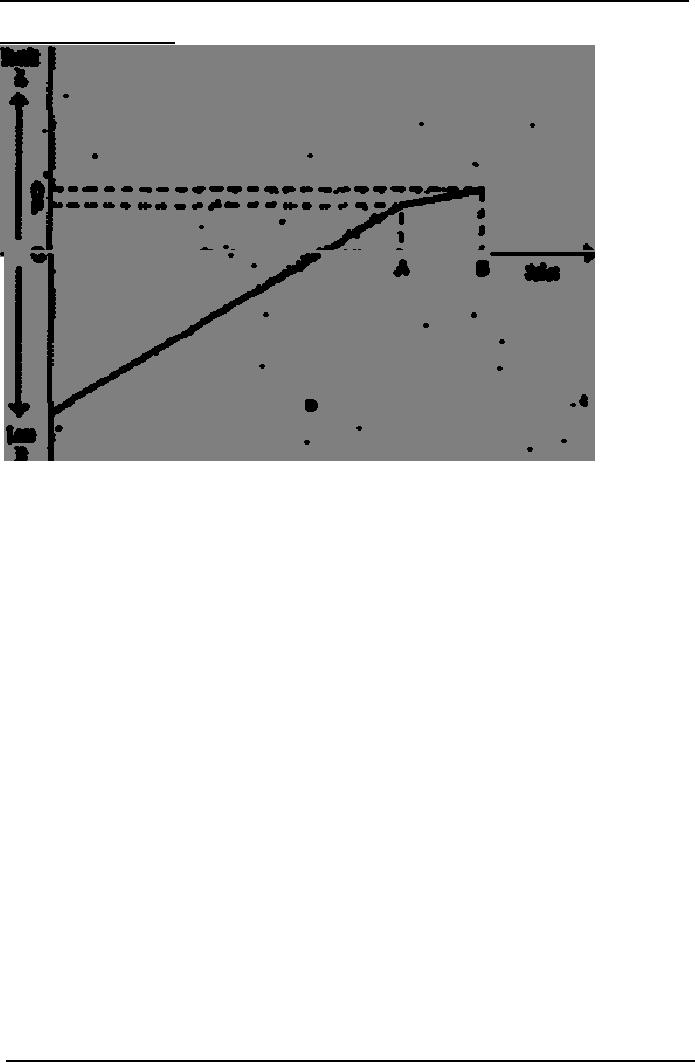 |

Cost
& Management Accounting
(MGT-402)
VU
LESSON#
32
BREAKEVEN
ANALYSIS CHARTS AND
GRAPHS
The
conventional break-even chart
The
conventional break-even chart
plots total costs and
total revenues at different
output levels
and
shows the activity level at
which break-even is
achieved.
Conventional
break-even chart
The
chart or graph is constructed as
follows:
�
Plot fixed costs, as a
straight line parallel to the
horizontal axis
�
Plot sales revenue and
variable costs from the
origin
�
Total costs represent fixed
plus variable costs.
The
point at which the sales
revenue and total cost lines
intersect indicates the breakeven
level of
output.
The amount of profit or loss
at any given output can be read
off the chart.
By
multiplying the sales volume
by the unit price at the
break-even point the level
of revenue
needed
to break even can be
determined.
The
chart is normally drawn up to
the budgeted sales
volume.
The
difference between the
budgeted sales volume and
break-even sales volume is referred to
as
the
margin of safety.
Usefulness
of charts
The
conventional form of break-even charts
was described above. Many
variations of such charts
exist
to illustrate the main relationships of
costs, volume and
profit.
Unclear
or complex charts should, however, be
avoided, as a chart which is
not easily understood
defeats
its own object.
Generally,
break-even charts are most
useful for the following
purposes:
�
comparing products, time periods or
actual outcomes versus planned
outcomes
�
showing the effect of
changes in circumstances or to
plans
�
giving a broad picture of
events,
195

Cost
& Management Accounting
(MGT-402)
VU
Contribution
break-even charts
A
contribution break-even chart is
constructed with the
variable costs at the foot
of the diagram
and
the fixed costs shown
above the variable cost
line.
The
total cost line will be in
the same position as in the
break-even chart illustrated
above; but by
using
the revised layout it is
possible to read off the
figures of contribution at various
volume
levels,
as shown in the following
diagram.
Profit-volume
chart
A
profit-volume chart is a graph which
simply depicts the net
profit and loss at any given
level of
activity.
196

Cost
& Management Accounting
(MGT-402)
VU
Profit
Sales
0
500
Breakeven
Point
Loss
1,000
Loss
= Fixed cost at zero sales
activity
From
the above chart the
amount of net profit or loss
can be read off for any
given level of sales
activity,
unlike a break-even chart
which shows both costs
and revenues over a given
range of
activity
but does not highlight
directly the amounts of
profits or losses at the various
levels.
�
The
points to note in the
construction of a profit-volume chart
are as follows:
�
The
horizontal axis represents
sales (in units or sales
value, as appropriate). This is the same
as
for
a break-even chart.
�
The
vertical axis shows net
profit above the horizontal
sales axis and net
loss below.
�
When
sales are zero, the net
loss equals the fixed
costs and one extreme of the
'profit-volume'
line
is determined. Therefore this is
one-point on the graph or
chart.
�
If
variable cost per unit
and fixed costs in total
are both constant throughout
the relevant range
of
activity under consideration, the
profit-volume chart is,
depicted by a straight line
(as
illustrated
above). Therefore, to draw
that line it is only
necessary to know the profit
(or loss)
at
one level of sales. The
'profit-volume ' line is then
drawn between this point
and the one for
zero
sales, extended as
necessary.
�
If
there are changes in the
variable cost per unit or
total fixed costs at various activities,
it
would
be necessary to calculate the
profit (or loss) at each
point where the cost
structure
changes
and to plot these on the
chart. The 'profit-volume'
line will then be a series
of straight
lines
joining these points
together, as shown in the
simple illustration
below.
197

Cost
& Management Accounting
(MGT-402)
VU
Profit-volume
chart (2)
This
illustration depicts the
situation where the variable
cost per unit increases
after a certain level
of
activity (OA), e.g. because
of overtime premiums that
are incurred when production
(and sales)
exceed
a particular level.
Points
to note:
�
The
profit (OP) at sales level
OA would be determined and
plotted.
�
Similarly
the profit (OQ) at sales
level of OB would be determined and
plotted.
�
The
loss at zero sales activity
(= fixed costs) can be
plotted.
�
The
"profit-volume' line is then
drawn by joining these
points, as illustrated.
As
long as we make the
assumptions that contribution
per unit is constant, and
fixed costs do not
change,
we can draw straight-line
graphs to show profit or
costs and revenues at all
possible
activity
levels.
MULTIPLE
CHOICE QUESTIONS
1.
If
contribution margin is
positive?
(a)
Profit will occur.
(b)
Both a profit and loss
are possible.
(c)
Profit will occur if the
fixed expenses are greater
than the contribution
margin.
(d)
A loss will occur if the
contribution margin is greater
than fixed expenses.
2. At
the breakeven point:
(a)
Profit is Rs. 0.
(b)
. Fixed Cost + Variable Cost =
Safes
(c)
Fixed Cost = Contribution
Margin
(d)
All of the above
198

Cost
& Management Accounting
(MGT-402)
VU
3.
A
completed CVP graph will show
that profit or loss at any
level of sales is measured
by:
(a)
A
vertical line between the
fixed cost line and
the x axis.
(b)
A
horizontal line between the
revenue line and the y
axis.
(c)
A
vertical line between the
total revenue line and the
total expenses line.
(d)
A
horizontal line between the
total revenue line and the
total expenses line.
4.
Contribution
margin ratio is:
(a)
Total
Contribution Margin /
Sales.
(b)
Sales
/ Contribution Margin per
unit,
(c)
Fixed
cost / Contribution margin
per unit.
(d)
Sales
/ Variable costs.
5.
The
impact on net operating income of any given dollar
change in total sales can be
computed
by
applying which ratio to the
dollar change?
(a)
Profit margin.
(b)
Variable cost ratio.
(c)
Contribution Margin.
(d)
Ratio of Variable to Fixed Expenses.
6.
The
Hino Corporation has a
breakeven point when sales
are Rs. 160,000 and
variable costs at
that
level of sales are Rs.
100,000. How much would
contribution margin increase or
decrease, if
variable
expenses dropped by Rs.
20,000?
(a)
37.5%.
(b)
60%.
(c)
12.5%.
(d)
26%
7.
Which
of the following represents
the CVP equation?
(a)
Sales
= Contribution margin + Fixed expenses +
Profits
(b)
Sales
= Contribution margin ratio + Fixed
expenses + Profits
(c)
Sales
= Variable expenses + Fixed expenses +
Profits
(d)
Sales
= Variable expenses - Fixed expenses +
Profits
8.
Margin
of Safety is a term best
described as the excess
of:
(a)
Contribution
margin over fixed
expenses.
(b)
Total
expenses over the breakeven
point.
(c)
Sales
over the breakeven
point.
(d)
Sales
over total costs.
Point
out which of the following statements are
TRUE/FALSE
1.
Cost-volume-profit
(CVP) analysis summarizes the effects of
change on an organization's
volume
of activity on its costs, revenue, and
profit.
2.
The
break-even point is the
volume of activity where an organization's
revenues and expenses
are
equal,
3.
Total
contribution margin can be
calculated by subtracting total
fixed costs from
total
revenues.
4.
Contribution
margin / Sales price per
unit = Contribution margin
ratio.
5.
The
sales price of a single unit
minus the unit's variable
expenses is called the unit
contribution
margin-
199

Cost
& Management Accounting
(MGT-402)
VU
6.
The
contribution-margin ratio of a firm is
determined by dividing the per
unit contribution
margin
by the per unit sales
price.
7.
The
safety margin of an enterprise is the
difference between the budgeted
sales revenue and
the
break-even sales revenue-
8.
A company's
break-even sales revenues
are Rs, 400,000, and its
contribution margin is 40%.
If
fixed
costs increase by Rs.
24,000, breakeven sales will
increase to Rs.
440,000.
9.
If
the total contribution
margin at break-even sales is
Rs, 45,000, then the
fixed costs must
also
be Rs. 45,000,
10.
If a company
sells 50 units of A at Rs. 8
contribution margin and 200
units of B at a Rs. 6
contribution
margin, the weighted-average contribution
margin is Rs. 7.00.
200
Table of Contents:
- COST CLASSIFICATION AND COST BEHAVIOR INTRODUCTION:COST CLASSIFICATION,
- IMPORTANT TERMINOLOGIES:Cost Center, Profit Centre, Differential Cost or Incremental cost
- FINANCIAL STATEMENTS:Inventory, Direct Material Consumed, Total Factory Cost
- FINANCIAL STATEMENTS:Adjustment in the Entire Production, Adjustment in the Income Statement
- PROBLEMS IN PREPARATION OF FINANCIAL STATEMENTS:Gross Profit Margin Rate, Net Profit Ratio
- MORE ABOUT PREPARATION OF FINANCIAL STATEMENTS:Conversion Cost
- MATERIAL:Inventory, Perpetual Inventory System, Weighted Average Method (W.Avg)
- CONTROL OVER MATERIAL:Order Level, Maximum Stock Level, Danger Level
- ECONOMIC ORDERING QUANTITY:EOQ Graph, PROBLEMS
- ACCOUNTING FOR LOSSES:Spoiled output, Accounting treatment, Inventory Turnover Ratio
- LABOR:Direct Labor Cost, Mechanical Methods, MAKING PAYMENTS TO EMPLOYEES
- PAYROLL AND INCENTIVES:Systems of Wages, Premium Plans
- PIECE RATE BASE PREMIUM PLANS:Suitability of Piece Rate System, GROUP BONUS SYSTEMS
- LABOR TURNOVER AND LABOR EFFICIENCY RATIOS & FACTORY OVERHEAD COST
- ALLOCATION AND APPORTIONMENT OF FOH COST
- FACTORY OVERHEAD COST:Marketing, Research and development
- FACTORY OVERHEAD COST:Spending Variance, Capacity/Volume Variance
- JOB ORDER COSTING SYSTEM:Direct Materials, Direct Labor, Factory Overhead
- PROCESS COSTING SYSTEM:Data Collection, Cost of Completed Output
- PROCESS COSTING SYSTEM:Cost of Production Report, Quantity Schedule
- PROCESS COSTING SYSTEM:Normal Loss at the End of Process
- PROCESS COSTING SYSTEM:PRACTICE QUESTION
- PROCESS COSTING SYSTEM:Partially-processed units, Equivalent units
- PROCESS COSTING SYSTEM:Weighted average method, Cost of Production Report
- COSTING/VALUATION OF JOINT AND BY PRODUCTS:Accounting for joint products
- COSTING/VALUATION OF JOINT AND BY PRODUCTS:Problems of common costs
- MARGINAL AND ABSORPTION COSTING:Contribution Margin, Marginal cost per unit
- MARGINAL AND ABSORPTION COSTING:Contribution and profit
- COST – VOLUME – PROFIT ANALYSIS:Contribution Margin Approach & CVP Analysis
- COST – VOLUME – PROFIT ANALYSIS:Target Contribution Margin
- BREAK EVEN ANALYSIS – MARGIN OF SAFETY:Margin of Safety (MOS), Using Budget profit
- BREAKEVEN ANALYSIS – CHARTS AND GRAPHS:Usefulness of charts
- WHAT IS A BUDGET?:Budgetary control, Making a Forecast, Preparing budgets
- Production & Sales Budget:Rolling budget, Sales budget
- Production & Sales Budget:Illustration 1, Production budget
- FLEXIBLE BUDGET:Capacity and volume, Theoretical Capacity
- FLEXIBLE BUDGET:ANALYSIS OF COST BEHAVIOR, Fixed Expenses
- TYPES OF BUDGET:Format of Cash Budget,
- Complex Cash Budget & Flexible Budget:Comparing actual with original budget
- FLEXIBLE & ZERO BASE BUDGETING:Efficiency Ratio, Performance budgeting
- DECISION MAKING IN MANAGEMENT ACCOUNTING:Spare capacity costs, Sunk cost
- DECISION MAKING:Size of fund, Income statement
- DECISION MAKING:Avoidable Costs, Non-Relevant Variable Costs, Absorbed Overhead
- DECISION MAKING CHOICE OF PRODUCT (PRODUCT MIX) DECISIONS
- DECISION MAKING CHOICE OF PRODUCT (PRODUCT MIX) DECISIONS:MAKE OR BUY DECISIONS